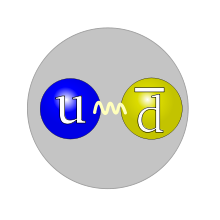
Pion

In particle physics, a pion (or a pi meson, denoted with the Greek letter pi: π) is any of three subatomic particles: π0, π+, and π−. Each pion consists of a quark and an antiquark and is therefore a meson. Pions are the lightest mesons and, more generally, the lightest hadrons. They are unstable, with the charged pions π+ and π− decaying with a mean lifetime of 26.033 nanoseconds (2.6033×10−8 seconds), and the neutral pion π0 decaying with a much shorter lifetime of 84 attoseconds (8.4×10−17 seconds). Charged pions most often decay into muons and muon neutrinos, while neutral pions generally decay into gamma rays.(>5% of decays) In particle physics, a pion (or a pi meson, denoted with the Greek letter pi: π) is any of three subatomic particles: π0, π+, and π−. Each pion consists of a quark and an antiquark and is therefore a meson. Pions are the lightest mesons and, more generally, the lightest hadrons. They are unstable, with the charged pions π+ and π− decaying with a mean lifetime of 26.033 nanoseconds (2.6033×10−8 seconds), and the neutral pion π0 decaying with a much shorter lifetime of 84 attoseconds (8.4×10−17 seconds). Charged pions most often decay into muons and muon neutrinos, while neutral pions generally decay into gamma rays. The exchange of virtual pions, along with vector, rho and omega mesons, provides an explanation for the residual strong force between nucleons. Pions are not produced in radioactive decay, but commonly are in high energy collisions between hadrons. Pions also result from some matter-antimatter annihilation events. All types of pions are also produced in natural processes when high energy cosmic ray protons and other hadronic cosmic ray components interact with matter in Earth's atmosphere. In 2013, the detection of characteristic gamma rays originating from the decay of neutral pions in two supernova remnants has shown that pions are produced copiously after supernovas, most probably in conjunction with production of high energy protons that are detected on Earth as cosmic rays. The concept of mesons as the carrier particles of the nuclear force was first proposed in 1935 by Hideki Yukawa. While the muon was first proposed to be this particle after its discovery in 1936, later work found that it did not participate in the strong nuclear interaction. The pions, which turned out to be examples of Yukawa's proposed mesons, were discovered later: the charged pions in 1947, and the neutral pion in 1950. Theoretical work by Hideki Yukawa in 1935 had predicted the existence of mesons as the carrier particles of the strong nuclear force. From the range of the strong nuclear force (inferred from the radius of the atomic nucleus), Yukawa predicted the existence of a particle having a mass of about 100 MeV. Initially after its discovery in 1936, the muon (initially called the 'mu meson') was thought to be this particle, since it has a mass of 106 MeV. However, later experiments showed that the muon did not participate in the strong nuclear interaction. In modern terminology, this makes the muon a lepton, and not a meson. However, some communities of astrophysicists continue to call the muon a 'mu-meson'. In 1947, the first true mesons, the charged pions, were found by the collaboration of Cecil Powell, César Lattes, Giuseppe Occhialini, et al., at the University of Bristol, in England. Since the advent of particle accelerators had not yet come, high-energy subatomic particles were only obtainable from atmospheric cosmic rays. Photographic emulsions based on the gelatin-silver process were placed for long periods of time in sites located at high altitude mountains, first at Pic du Midi de Bigorre in the Pyrenees, and later at Chacaltaya in the Andes Mountains, where the plates were struck by cosmic rays. After the development of the photographic plates, microscopic inspection of the emulsions revealed the tracks of charged subatomic particles. Pions were first identified by their unusual 'double meson' tracks, which were left by their decay into a putative meson. The particle was identified as a muon, which is not typically classified as a meson in modern particle physics. In 1948, Lattes, Eugene Gardner, and their team first artificially produced pions at the University of California's cyclotron in Berkeley, California, by bombarding carbon atoms with high-speed alpha particles. Further advanced theoretical work was carried out by Riazuddin, who in 1959, used the dispersion relation for Compton scattering of virtual photons on pions to analyze their charge radius. Nobel Prizes in Physics were awarded to Yukawa in 1949 for his theoretical prediction of the existence of mesons, and to Cecil Powell in 1950 for developing and applying the technique of particle detection using photographic emulsions. Since the neutral pion is not electrically charged, it is more difficult to detect and observe than the charged pions are. Neutral pions do not leave tracks in photographic emulsions or Wilson cloud chambers. The existence of the neutral pion was inferred from observing its decay products from cosmic rays, a so-called 'soft component' of slow electrons with photons. The π0 was identified definitively at the University of California's cyclotron in 1950 by observing its decay into two photons. Later in the same year, they were also observed in cosmic-ray balloon experiments at Bristol University. The pion also plays a crucial role in cosmology, by imposing an upper limit on the energies of cosmic rays surviving collisions with the cosmic microwave background, through the Greisen–Zatsepin–Kuzmin limit.
